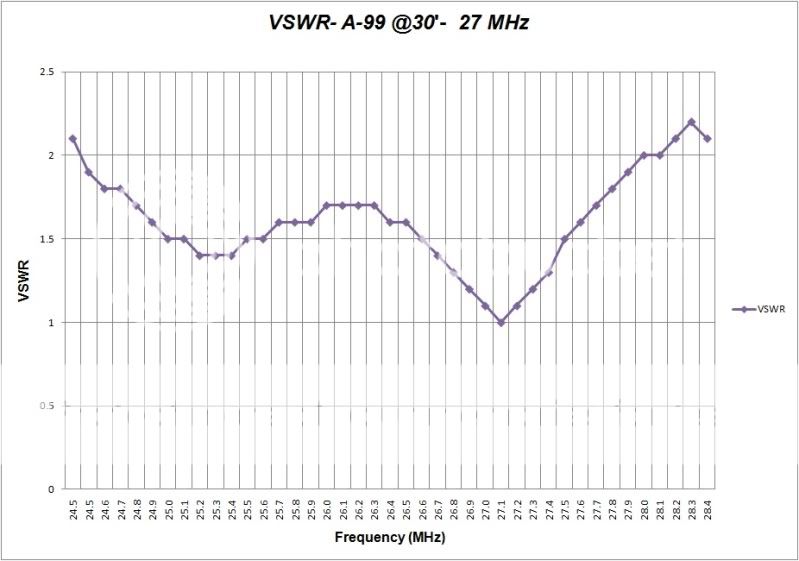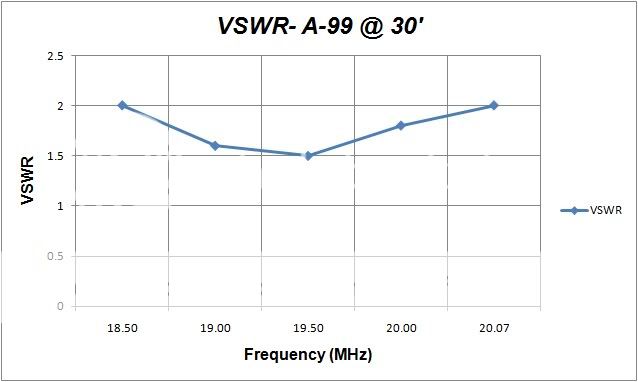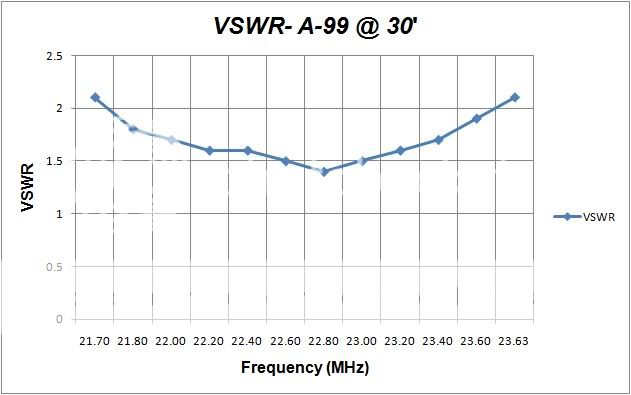Well Oldtimer,
Rather than rely on my memory (which is suspect already!) I thought I’d take a few minutes and actually measure what my A-99 looks like. First thing, it’s actually fed with 100’ of LMR-400, not 75’—it’s my yagi that’s fed with 75’, sorry for the error. Here’s what I measured with my MFJ-259, measured at my operating position through a 10’ jumper into a switch:

(24.5 appears twice because I had to round the numbers off to one decimal place so the chart wouldn't be so cluttered. The 2:1 point was 24.518 MHz.)
Not bad, really. I remember now during my testing that I tried to shift the whole thing upward a few hundred KHz to get more of 10m while still getting 12m, but that just did not happen. As I recall, the tuning in its final position, 30 feet in the air (the bottom of the antenna) was not much different from the testing position at 15 feet.
So, the 2:1 VSWR bandwidth on my A-99 as it stands is 3.52 MHz—which ain’t too shabby. The 2:1 bandwidth of the little ground plane was 4.05 MHz. So while it was better in that regard, it wasn’t all that much better, though I think I could have adjusted it to cover 12 through 10 if I’d been serious about it.
Here are a couple of interesting measurements:


These fall just outside the amateur bands of course, and I see several moments of low VSWR in the VHF spectrum (not 6 or 2 meters, dang it…)
I’m curious to see what other folks are seeing from their A-99s, and whether this is typical (I'd guess it is).
Rick
Rather than rely on my memory (which is suspect already!) I thought I’d take a few minutes and actually measure what my A-99 looks like. First thing, it’s actually fed with 100’ of LMR-400, not 75’—it’s my yagi that’s fed with 75’, sorry for the error. Here’s what I measured with my MFJ-259, measured at my operating position through a 10’ jumper into a switch:

(24.5 appears twice because I had to round the numbers off to one decimal place so the chart wouldn't be so cluttered. The 2:1 point was 24.518 MHz.)
Not bad, really. I remember now during my testing that I tried to shift the whole thing upward a few hundred KHz to get more of 10m while still getting 12m, but that just did not happen. As I recall, the tuning in its final position, 30 feet in the air (the bottom of the antenna) was not much different from the testing position at 15 feet.
So, the 2:1 VSWR bandwidth on my A-99 as it stands is 3.52 MHz—which ain’t too shabby. The 2:1 bandwidth of the little ground plane was 4.05 MHz. So while it was better in that regard, it wasn’t all that much better, though I think I could have adjusted it to cover 12 through 10 if I’d been serious about it.
Here are a couple of interesting measurements:


These fall just outside the amateur bands of course, and I see several moments of low VSWR in the VHF spectrum (not 6 or 2 meters, dang it…)
I’m curious to see what other folks are seeing from their A-99s, and whether this is typical (I'd guess it is).
Rick
